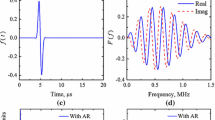Abstract
This paper presents a theoretical model and corresponding experimental results of the oblique-incidence response of a luminescent photoelastic coating (LPC). LPCs use a luminescent dye that both partially preserves the stress-modified polarization state and provides high emission signal strength at oblique surface orientations. These characteristics enable the technique to acquire full-field strain separated measurements and principal strain directions, potentially on complex three-dimensional geometries, without the use of supplemental experimental or analytical techniques. Results of a single-layer LPC on a disk in diametral compression are presented to assess a theoretical model and evaluate the measurement sensitivity.
















Similar content being viewed by others
Notes
The luminescent intensity naturally decreases as surface inclination angle increases because of the high to low refraction index change.
References
Zandman F, Redner S, Dally JW (1977) Photoelastic coatings. Iowa State University Press, Ames.
Lesniak JR, Zickel MJ (1998) Applications of Automated Grey-Field Polariscope. Proceedings of Society of Experimental Mechanics Spring Conference, June, pp. 298–301.
Ramesh K, Mangal SK (1998) Data acquisition techniques in digital photoelasticity: a review. Opt Lasers Eng 30:53–75.
Drucker DC (1943) Photoelastic separation of principal stresses by oblique incidence. Journal of Applied Mechanics, Trans. ASME 65:A156–A160.
Redner SS (1963) New oblique-incidence method for direct photoelastic measurement of principal strains. Exp Mech 3(3):67–72.
O’Regan R (1965) New method for determining strain on the surface of a body with photoelastic coatings. Exp Mech 5(8):241–246.
Barone S, Patterson EA (1996) Full-field separation of principle stresses by combined thermo- and photoelasticity. Exp Mech 36(4):318–324.
Hubner JP, Ifju PG, Schanze KS, Jiang S, Liu Y, El-Ratal W (2004) Luminescent strain sensitive coatings. AIAA J 42(8):1662–1668.
Hubner JP, Ifju PG, Schanze KS, Liu Y, Chen L, El-Ratal W (2004) Luminescent photoelastic coatings. Exp Mech 44(4):416–424.
Hubner J, Chen L, Liu Y, Schanze K, Nicolosi J, Ifju P, El-Ratal W (2005) Characterization of a new luminescent photoelastic coating. Exp Mech 45(2):137–143.
Hubner J, Nicolosi J, Chen L, Ifju P, El-Ratal W (2005) Oblique incidence response of photoelastic coatings. Exp Tech 29(3):52–56.
Hecht E (1987) Optics, 2nd edition. Addison-Wesley, Reading, MA, 1 pp. 92–104.
Lakowicz JR (1983) Principles of fluorescent spectroscopy. Plenum, New York, pp. 111–120.
Frocht MM (1948) Photoelasticity Vol. II. Wiley, New York, pp. 118–155.
Timoshenko SP, Goodier JN (1970) Theory of elasticity, 3rd edition. McGraw-Hill, London, pp. 122–126.
Woolard D, Hinders M (2000) Model for quantifying photoelastic fringe degradation by imperfect retroreflective backings. Appl Opt 39(1):2043–2053.
Author information
Authors and Affiliations
Corresponding author
Appendix
Appendix
Expressions for the coefficients A and B in equation (8) are
and
Rights and permissions
About this article
Cite this article
Hubner, J.P., Chen, L. Coupled Strain and Fresnel Response of Photoelastic Coatings at Oblique Incidence. Exp Mech 47, 549–560 (2007). https://doi.org/10.1007/s11340-007-9033-0
Received:
Accepted:
Published:
Issue Date:
DOI: https://doi.org/10.1007/s11340-007-9033-0




